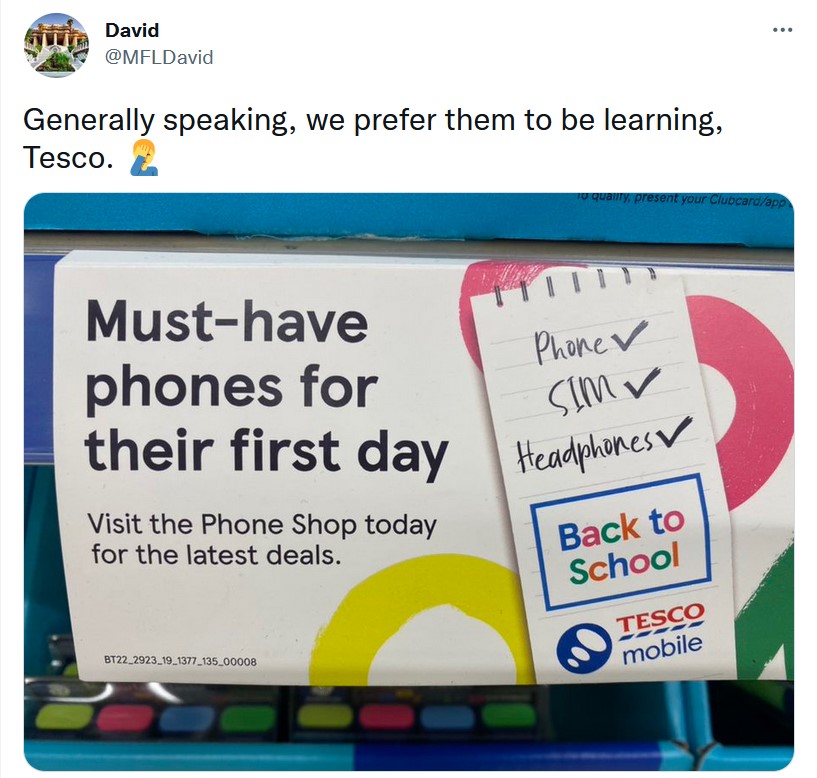Supermarkets are really good at making things go viral these days. Who didn’t love the image of a whole shelf full of wine bottles labelled “office essentials” during the height of PartyGate? They know how to push people’s buttons on social media in order to keep their brand in the spotlight.
One can only assume that the potential to go viral was the purpose of this display, photographed and shared by an MFL teacher called David on Twitter this weekend:

Predictably, and presumably as part of Tesco’s dastardly plan to go viral, EduTwitter went beserk. Huge numbers of us, myself included, were pretty annoyed about the fact that Tesco were depicting a mobile phone as an “essential” for children heading into school. Yet this notion is not an outlier and Tesco certainly did not come up with it on their own; I am reliably informed by multiple friends who are parents that it is now considered to be a “rite of passage” for children to receive a smart phone when they enter secondary school (if their parents haven’t caved in already), so Tesco know what they’re doing here.
There is overhwhelming evidence that mobile phones cause problems in a school environment, which is why so many schools have moved towards banning them in recent years. Many teachers have expressed growing concerns that smart phones pose a significant safeguarding threat and a tool which aids and abets bullying and child-on-child abuse. This is now well-evidenced. Most fundamentally of all however – given that schools are meant to be a place where children learn – the basic problem with smart phones is that they are weapons of mass distraction.
A blogpost by Innerdrive sums up the research evidence on mobile phone usage in schools and it makes for sobering reading. While much of the research focuses on the usefulness of banning phones in a school setting, there is also a great deal of evidence which should give parents serious pause for thought about their child’s usage of devices at home, particularly at night-time. In summary: please don’t let your child have access to their phone after bedtime and please make sure that you have access to everything your child is doing and seeing online and that you check this regularly.
What has puzzled me most in this whole thing is the number of people still willing to defend the notion of children having access to these devices throughout the school day. Unsurprisingly, not very many of them are classroom teachers. They are “educators”, EdTech pushers or – occasionally – much-loved children’s poets. Most teachers have been concerned about children’s usage of smart phones from day one, and those who have defended the notion in the past have in many cases shifted their viewpoint. One of the most irksome arguments used against banning phones in schools is the viewpoint that children must be educated in their usage and that banning them is part of schools being “out of touch” with the modern world. Okay. Apply that argument to sex education: children should be allowed to experiment with sex in school because they need to be taught how to do it responsibly. Apply the argument to alcohol and drug usage: children should be allowed to use alcohol and drugs in school so that we can teach them how to do so responsibly. And so on. Of course students need to be taught about responsible internet usage and the dangers of social media, and believe you me they get this by the bucket-load. But to suggest that in order to learn about the use of smart phones they need to have ready access to these devices in school (as if somehow otherwise they wouldn’t know what we’re talking about?) is laughable.
One of my earliest shows for Teachers’ Talk Radio explored the relationship that teenagers have with their smart phones and my guest, Dr. Kathy Weston from Tooled Up Education, used the phrase “digital hygiene” to summarise the kinds of discussions and agreements that should go on between parents and their child at the point when a child is given one of these devices. It’s important to note where the responsibility lies here: with the parents who, after all, are paying the bill. Of course schools should be addressing mobile phone usage as a part of their PSHE programme, and I cannot imagine there is a school in the land not doing so. But dealing with this issue in schools is a dismal attempt to hang a sheet over a door that a horse has not only bolted through but slammed so hard that the door is off its hinges. In my show I also interviewed Matt Crowley, lead DSL (Designated Safeguarding Lead) in the school in which I was working at the time; the serious safeguarding risks and the systemic damage to a child’s mental health, self-esteem and personal safety which can arise from the use of these devices – in school and beyond – simply cannot be over-emphasised, I’m afraid.
Defenders of the smart phone in schools piont to its “education benefits” and there is no question that there are multiple apps that children can make use of in their learning journey. However, it is a full-time job to micro-manage this kind of usage and that can only be done by a parent or carer. If only we could trust all of our children to make use of their phones to access their Latin vocabulary on Quizlet during break and lunchtimes! In reality, anyone who thinks that’s what they are doing with them is seriously deluded. During the period in which smart phones had become endemic amongst young people when I was working in schools, I knew of numerous cases of children accessing pornography and videos produced by terrorist organisations; I knew of cases in which these devices were used for horrific and systemic bullying, to film teachers and humiliate them on social media, and for children to watch age-inappropriate films and play age-inappropriate games. You name it, I’m afraid they’ve probably done it and done it in school. Is that what people want for their child?
So schools must hold the line and maintain their ban – not that I know of a single one that regrets it – and parents can (I hope) take inspiration from it. These devices are wondrous and I fully admit that I could not live without mine. I first attained a smartphone at the age of around 35, which is probably responsible enough. I cannot tell you how glad I am that they did not exist when I was a child.
My final thought brings me back to my new full-time role, as a professional tutor. It is a discussion I have had to have with numerous parents, advising them to take away a child’s mobile phone while they access my sessions. Working online, it is particularly difficult to spot when a child is distracted by their device, but I can still spot it. Most children find it too difficult to discipline themselves not to look at their phones whilst they’re doing anything (even something they enjoy!) so the odds of them being able to resist it during a tutoring session are vanishingly slim. So take control, which means take the device. They’ll thank you for it one day.
